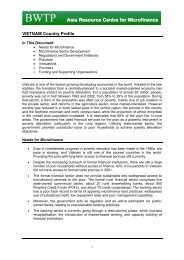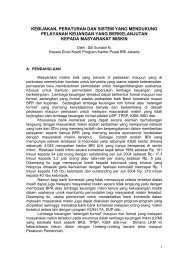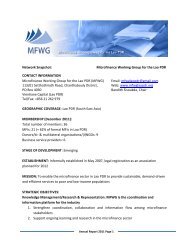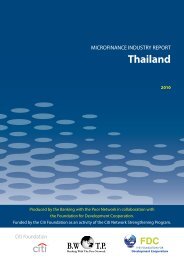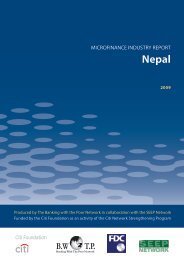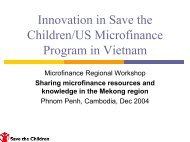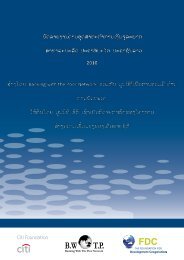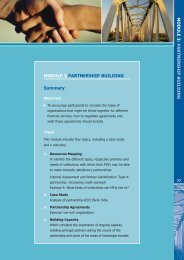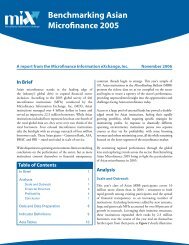Micro Finance in India - Banking with the Poor Network
Micro Finance in India - Banking with the Poor Network
Micro Finance in India - Banking with the Poor Network
You also want an ePaper? Increase the reach of your titles
YUMPU automatically turns print PDFs into web optimized ePapers that Google loves.
B A S I X :--- The Papers & Publications<br />
http://www.basix<strong>in</strong>dia.com/micro_f<strong>in</strong>ance_<strong>in</strong>_<strong>in</strong>dia.htm<br />
Page 5 of 10<br />
27/08/03<br />
150-250 68 32 100<br />
250 and above 81 19 100<br />
All Classes 64 36 100<br />
Over <strong>the</strong> decades follow<strong>in</strong>g <strong>India</strong>'s <strong>in</strong>dependence <strong>in</strong> 1947, Government of <strong>India</strong> (GOI) has made<br />
concerted efforts to provide micro-f<strong>in</strong>ance to <strong>the</strong> rural poor through <strong>the</strong> formal f<strong>in</strong>ancial sector namely<br />
<strong>the</strong> co-operatives. However, <strong>the</strong> limited success of <strong>the</strong> co-operatives <strong>in</strong> <strong>the</strong> mid fifties to <strong>the</strong> sixties<br />
forged <strong>the</strong> need for nationalisation of commercial banks (CB) <strong>in</strong> 1971 and <strong>the</strong> establishment of a large<br />
network to reach every village, and every segment of <strong>the</strong> population. In <strong>the</strong> mid-1970s, Regional<br />
Rural Banks (RRB) were also established to cont<strong>in</strong>ue fur<strong>the</strong>r <strong>the</strong> outreach of <strong>the</strong> bank<strong>in</strong>g sector <strong>in</strong><br />
reach<strong>in</strong>g <strong>the</strong> rural poor. All <strong>the</strong>se programs were supported by a policy of mandated credit programs<br />
for <strong>the</strong> low-<strong>in</strong>come households that were supported by <strong>the</strong> Integrated Rural Development Program<br />
(IRDP), launched <strong>in</strong> 1980. The IRDP was designed to provide a mix of subsidy from <strong>the</strong> government<br />
and credit from <strong>the</strong> bank<strong>in</strong>g system to enable <strong>the</strong> asset acquisition of <strong>the</strong> poor.<br />
As a result of <strong>the</strong>se programs, <strong>India</strong> has one of <strong>the</strong> largest bank<strong>in</strong>g networks <strong>in</strong> <strong>the</strong> world <strong>with</strong> close to<br />
50,000 CB outlets; 14,420 RRBs; and 90,000 primary agricultural co-operative societies. Close to 43<br />
percent of <strong>the</strong> CB, and RRB branches are located <strong>in</strong> <strong>the</strong> rural areas. Even more impressive is <strong>the</strong> fact<br />
that, <strong>the</strong>re is a f<strong>in</strong>ancial <strong>in</strong>termediary branch for every 15,000 households, and a co-operative <strong>in</strong> every<br />
village.<br />
Due to <strong>the</strong> extensive expansion of <strong>the</strong> bank<strong>in</strong>g network and emphasis on lend<strong>in</strong>g to small borrowers,<br />
<strong>the</strong>re have been a lot of small loans by banks. In terms of amount, this was 13.2 percent of <strong>the</strong> total<br />
credit outstand<strong>in</strong>g from commercial banks and RRBs. As per RBI data for March 1994, <strong>the</strong> number of<br />
accounts below Rs 25,000 was 5.6 million, or 93.6 percent of total loan accounts, <strong>with</strong> 18.6 percent of<br />
<strong>the</strong> outstand<strong>in</strong>g amount. Of <strong>the</strong>se, accounts <strong>with</strong> outstand<strong>in</strong>g below Rs 7500 comprised 80.5 percent<br />
of <strong>the</strong> number of accounts and 49.5 percent of amount outstand<strong>in</strong>g. In terms of purpose, 45.8 percent<br />
of amount was for small agricultural loans, 20.2 percent for <strong>in</strong>dustry and 18.8 percent for trade and<br />
services.<br />
By March 1997, <strong>the</strong> number of small borrowal accounts <strong>with</strong> a credit limit below Rs 25,000, had come<br />
down by as many 0.6 million accounts to 5.0 million, or 90.1 percent of <strong>the</strong> outstand<strong>in</strong>g loan accounts.<br />
This decl<strong>in</strong>e <strong>in</strong> number of accounts clearly shows <strong>the</strong> post liberalisation trend, <strong>with</strong> banks<br />
concentrat<strong>in</strong>g <strong>the</strong>ir efforts on larger loans and becom<strong>in</strong>g ever more reluctant to extend credit to small<br />
borrowers.<br />
While banks have been engaged <strong>in</strong> f<strong>in</strong>anc<strong>in</strong>g small borrowers, <strong>the</strong> manner <strong>in</strong> which this is be<strong>in</strong>g done<br />
can hardly be called micro-f<strong>in</strong>ance. The procedures are cumbersome, <strong>the</strong> staff unfriendly and <strong>the</strong><br />
transaction costs high. Repeat loans, except for crop production, are rare, even for borrowers who<br />
have repaid fully. Fur<strong>the</strong>rmore, even though <strong>the</strong> many of <strong>the</strong> loans extended to <strong>the</strong> poor by <strong>the</strong> public<br />
sector f<strong>in</strong>ancial <strong>in</strong>stitutions are subsidized, <strong>the</strong>ir ultimate cost to <strong>the</strong> borrowers is high: factor<strong>in</strong>g <strong>in</strong><br />
out-of-pocket costs, payments to middle men, wage and bus<strong>in</strong>ess loss due to time spent <strong>in</strong> gett<strong>in</strong>g <strong>the</strong><br />
loan approved. Effectively, <strong>the</strong> total cost of funds to <strong>the</strong> borrower ranges between 22–30 percent as<br />
aga<strong>in</strong>st <strong>the</strong> 12-14 percent nom<strong>in</strong>al lend<strong>in</strong>g rates specified for commercial bank loans below Rs<br />
200,000. All this results <strong>in</strong> low repayment rates, lead<strong>in</strong>g to a vicious cycle of non-availability and nonrepayment.<br />
Supply of Sav<strong>in</strong>gs and Insurance Services:<br />
In <strong>the</strong> case of sav<strong>in</strong>gs services, aga<strong>in</strong> while banks have provided access to a large number of small<br />
depositors, <strong>the</strong> demand is nowhere near be<strong>in</strong>g met, particularly for small , frequent "recurr<strong>in</strong>g"<br />
deposits. Hence <strong>the</strong> poor turn to o<strong>the</strong>r means such as chits, bishis and sav<strong>in</strong>gs mobilisation companies<br />
like Peerless and Sahara. Many such companies are fly-by night and as a result, <strong>the</strong> poor lose <strong>the</strong>ir<br />
money. The RBI has tightened up deposit tak<strong>in</strong>g activity s<strong>in</strong>ce 1997, but this has, perversely, also led<br />
to legitimate MFIs be<strong>in</strong>g not allowed to take deposits and thus provide sav<strong>in</strong>gs services to <strong>the</strong> poor.<br />
Transaction costs of sav<strong>in</strong>gs <strong>in</strong> formal <strong>in</strong>stitutions were as high as 10 percent for <strong>the</strong> rural poor,



